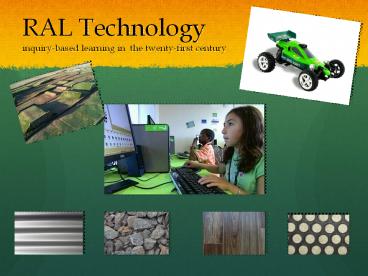RAL technology - PowerPoint PPT Presentation
Title: RAL technology
1
RAL Technologyinquiry-based learning in the
twenty-first century
2
Introduction
3
RAL Technology
- What is a RAL (Remote Access Laboratory)?
- RAL allow users to have experiments set up in a
laboratory as per project requirements with state
of the art equipment. - Users are then able to log into the lab via the
Internet and control all of the equipment and
record results in real-time from a remote
location.
4
RAL Technology
- Benefits of RAL
- Access to sophisticated scientific equipment
otherwise inaccessible in conventional school
science programs due to expense and time
restraints - Access not limited by location or time zone
- Provides superior access for students with
disabilities - Students are able to log into the lab via the
Internet and control all of the equipment and
record results in real-time from a remote
location. - See Resources 1 for detailed examination of RAL
technology and benefits
5
Inquiry Task
- Inquiry Learning components of this unit have
been designed to complement Science, Technology
and ICT - Students must gather information, test design
elements and record data. - The process will raise such questions as Will
this work?, Why doesnt it work?, What can I do
to make it work? - See Resources 2 for detailed Inquiry analysis
6
KLAKey Learning Areas
- Science
- Energy and Change
- Technology
- Technology as a human endeavour
- Information, materials and systems (resources)
- ICTs
- Inquiring with ICTs
- See Resources 3 for detailed presentation of
KLAs
7
GRASPS
The task uses the GRASPS design
model. Goal Role Audience Situation Product
Standards for Success
Wiggins, G. McTighe, J. ( 2003). Understanding
by design Teaching Assessing for in-depth,
engaging and effective learning. Professional
Workshop. San Francisco ASCD.
8
Goal
- Using knowledge of force and motion, design a
challenging and fun all weather remote control
car track for a public community space. - Drive a test vehicle in a remote access
laboratory (RAL) to experiment with surfaces,
gradients, cornering and straights. - Collect data then justify resulting design
decisions .
9
Role
- Students will work in teams of two. They will
assume the role of LANDSCAPE ARCHITECTS who are
preparing a design to tender for the job of
building the remote control car track for a
community space. - They are given specifications to which they must
adhere for example, the track must include a
particular number of surfaces, a variety of
gradients, and options for beginner and advanced
drivers. - They will justify their design upon completion
by providing data collected during RAL trials.
10
Audience
- When the designs and justifications are complete,
they will be judged by a panel of community
members and representatives from the Radiator
Springs Council. - The panel will rate the designs and award the job
of building the track to the team with the best
design.
11
Situation
- Teams of two
- Submissions are to be of a revolutionary nature,
giving the community a state of the art racing
complex. - There is ample space to build a track which can
be used by all members of the community
children, youth and adults. - The council requirements are for an all weather
track, that will be usable at all times of the
year. - The council is looking for a facility that will
be able to sustain competitions being held at the
track over long weekend periods for example.
12
Product
- The design proposal (drawn/computer generated)
- The proposed track must include
- Sections suitable for beginner and advanced
remote control car users - Surfaces which will be suitable for all weather
conditions - A variety of surfaces, gradients, straights and
corners - Justification of design decisions must include -
- Data gathered during testing potential surfaces
and gradients - Links to scientific knowledge of force and motion
13
Standards for Success
- Designs must
- Be neatly presented either drawn or computer
generated and clearly labeled - Meet specifications of using a variety of
surfaces, gradients, straights and corners - Be suitable for both beginner and advanced users
- Be supported with relevant data and scientific
justifications































